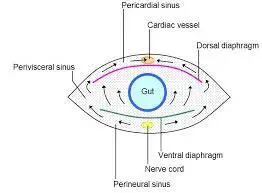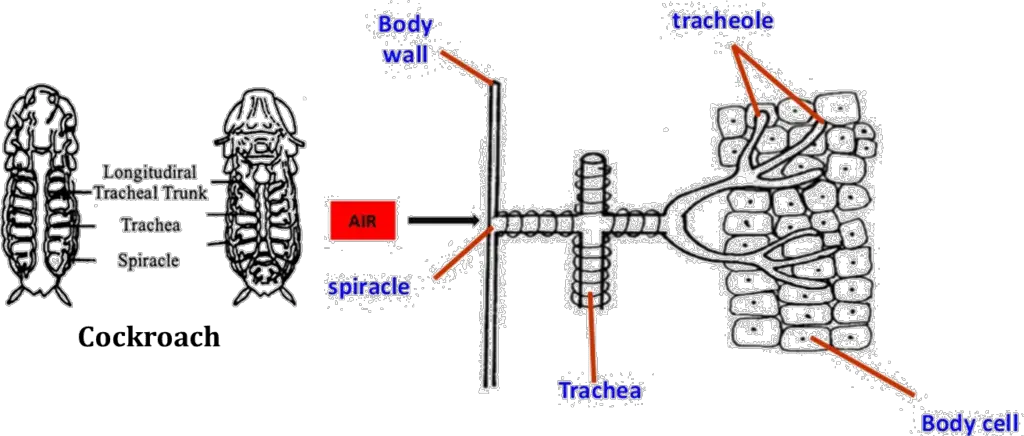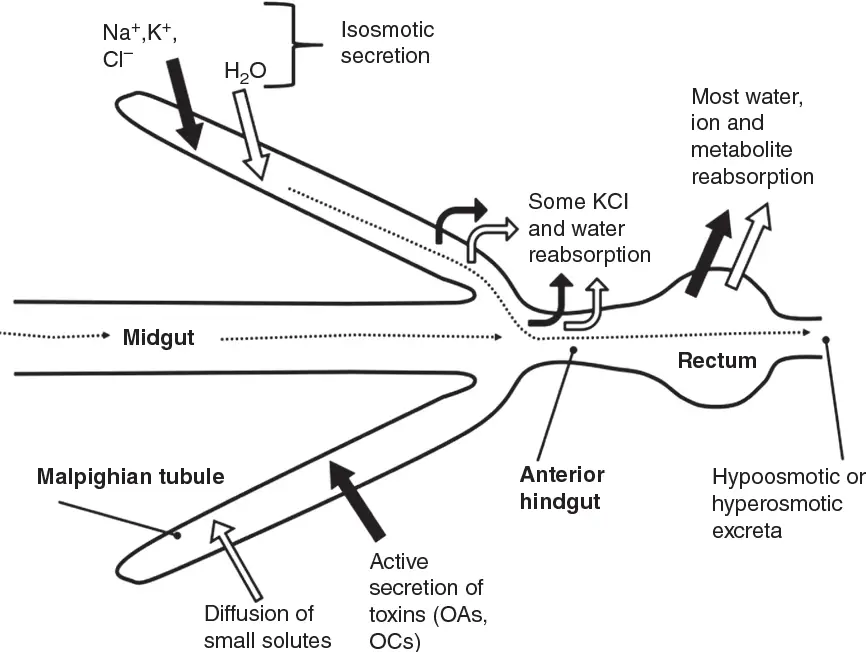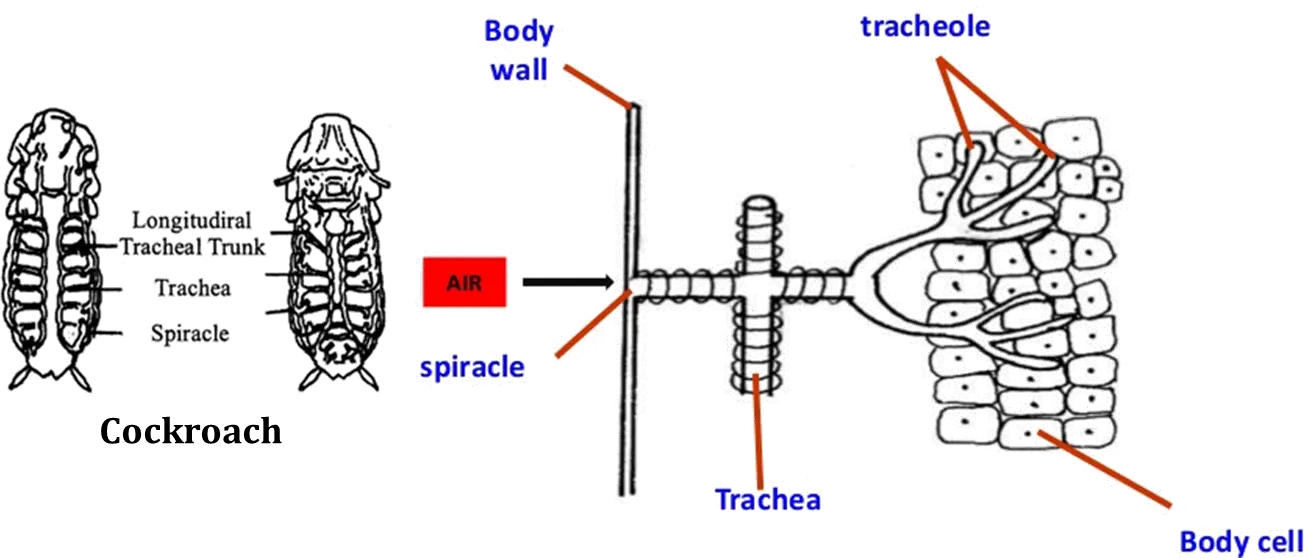Hi, today we are going to discuss a different organ system in cockroaches, the circulatory respiratory excretory system of cockroaches. We have already discussed the alimentary canal of cockroaches and the anatomy of cockroaches in a previous post, If you want to know about them then you can read it before you read more organ systems of cockroaches.
The cockroach is a member of Arthropoda so if you study different organ systems in cockroaches then it will give you ideas about other animals also. Another benefit of studying different organ systems in cockroaches will help you to understand other advanced organ systems in higher animals easily.
Table of Contents
Circulatory System of Cockroach:
Like other insects, cockroaches have an open circulatory system and their circulatory system is lacunar type so their circulatory fluid is not limited in vessels as observed in a closed circulatory system.
The body cavity of cockroaches is filled with circulatory fluid in which all their visceral organs are present in a bathing state. The visceral organs are present in the fluid-filled body cavity which is known as haemocoel and different visceral organs take their requirements like nutrients from the haemocoel fluid.
Circulatory systems of cockroaches have anterior aorta, multi-chambered tubular heart, sinus or blood spaces all of which will be discussed below.

Blood Sinus in Cockroach:
The term sinus means an open space in cockroaches the haemocoel of their body cavity is divided into three cavity-like spaces by two membranous horizontal partitions. The two horizontal partitions make the sinus into three horizontal chambers – dorsal pericardial sinus, middle perivisceral sinus and ventral perineural sinus.
The dorsal pericardial sinus bath the heart, middle perivisceral sinus bath the gut content and the perineural sinus or sternal sinus bath the nerve cord. A cockroach has two diaphragms one between the pericardial sinus and the perivisceral sinus which is called as dorsal diaphragm while another diaphragm is present at the partition of the perineural sinus and perivisceral sinus which is called the ventral diaphragm.
Both the dorsal diaphragm and ventral diaphragm have several pores which help to establish interconnection between the three sinuses pericardial sinus, perivisceral sinus and perineural sinus.
At the floor of the dorsal diaphragm in the pericardial sinus, there is a triangular-shaped muscle present in each segment called an alary muscle which reinforces the dorsal diaphragm with the help of their broad base and the pointed tip which connected to the tergite of that segment.
Circulation of Hemolymph in Cockroach:
The haemolymph present in their body cavity is pumped by their tubular multi-chambered heart and the alary muscle movement. Now we will discuss how the haemolymph circulates throughout the body in cockroaches with the help of pulsating action of their tubular heart and alary muscle activity.
At first, haemolymph goes inside their heart through the special pore present in their heart Ostia from the pericardial sinus. The valves present in Ostia prevent the backflow of haemolymph from their heart to the pericardial sinus then some portion of haemolymph reach segmental vessels.
The Majority of the hemolymph from the heart goes into the head sinus through the anterior aorta which is present in the terminal part of the body.
Then from the head sinus, the haemolymph enters into the perineural sinus and reach the thoracic region and abdominal region then the haemolymph enters into the perivisceral sinus through the pores present in the ventral diaphragm.
Then the hemolymph enters into the pericardial sinus again from the perivisceral sinus through the pores present on the dorsal diaphragm and again the haemolymph enters into the heart this process continues always to keep the circulation on throughout the whole body of a cockroach.

Respiratory System of Cockroach:
Like other insects cockroaches also have fine air tubules which are known as trachea which makes a network in this whole body for gaseous exchange in tissues. The opening of the trachea occurs through the 10 pairs of pores present on the lateral side of their body to collect air from outside and pass them inside the body up to each tissue.
The pores through which the trachea open outside is called spiracles which are guarded by a sphincter and the gaseous exchange occurs by the process of diffusion from the fine end of the trachea and tracheole.

FlexiPrep
Excretion System of Cockroach:
Malpighian tubules are a characteristic of major insects. Also, cockroaches have Malpighian tubules for excretion. The ciliated cell present in the inner lining of Malpighian tubules absorbs nitrogenous waste materials which are excreted in the form of uric acid through the hindgut while other structures like fat body, nephrocytes and urecose glands also take part in excretion.

Topic Related to “Circulatory Respiratory Excretory System of Cockroach“:
| Male and Female Reproductive System of Cockroaches |
| Morphology of Cockroach |
| Different modes of excretion in animals |
| Blood Circulatory System |
| Breathing in Different Animals |
Reference: Circulatory Respiratory Excretory System of Cockroach
Which Type of Circulatory System Observed in Cockroaches?
Cockroach and other insects have an open circulatory system in which the body fluid does not limit inside blood vessels instead the body fluid open into a body cavity and other visceral organs present in the body fluid-filled body cavity and take necessary materials from the body cavity.
What is Haemocoel?
In cockroach and other insects body fluid open into a large body cavity and this cavity is known as haemocoel in which the visceral organs take their essential material and release unwanted metabolic waste.
What are Sinuses in the Circulatory System of Cockroaches?
The term sinus refers to an open space and in the circulatory system of cockroaches, the body fluid opens into a cavity like open space which is known as a sinus. In cockroaches, the sinus is three-chambered because the dorsal and ventral diaphragm makes the sinus upper pericardial sinus, middle perivisceral sinus and lower perineural sinus.
Which Type of Heart is Present in Cockroach?
In a cockroach, the heart is 13 chambered which are pulsating in nature and the heart in cockroach is myogenic. Rhythmic heartbeat produces in the heart as a result of the nervous impulse produced by the cluster of neurones present in the cardiac ganglion and the heart is tubular in structure.
What is the Role of Alary Muscles in Cockroaches?
In the pericardial sinus at the wall of the heart paired triangular muscles are attached which help in pumping the heart and when the alary muscles contracts body fluid flow into the pericardial sinus from the perivisceral sinus and then the body fluid enter into the multichambered heart.
What is Ostia in Cockroach and What is the Role of Ostia?
The cockroach has 13 chambered hearts and on the lateral side of each chamber of the heart has 2 pores through which haemolymph enter into the heart from the pericardial sinus and those pores are known as Ostia, Ostia are protected by a special type of valve which prevents the backflow of body fluid from heart to pericardial sinus.
What is the Respiratory Organ in Cockroach?
Like other insects cockroaches respire through a special type of fine tubular structure present throughout the body and those tubules are known as the trachea. The trachea is opened outside of the body through the pore present on the lateral side are known as spiracles which are guarded by a sphincter, the trachea breaks down into fine tracheole which helps in gaseous exchange up to almost all tissues.
What is the Primary Excretory Organ of Cockroach?
In cockroaches, the primary excretory organ is a tubular structure attached to their digestive tract known as Malpighian tubules but some other structures, fat body, nephrocytes and urecose glands also take part in excretion. The inner lining of the lumen of Malpighian tubules has ciliated cells which collect the nitrogenous waste material from the digestive tract and then the nitrogenous waste materials are excreted as uric acid.
What is Urecose Gland in Cockroach?
In male cockroaches, a special type of gland is present at the posterior end of their body near the mushroom gland are known as urecose gland or Utriculi Majoris which stores nitrogenous excretory materials and help in the excretion of uric acids.
What is the Role of Nephrocyte in Cockroach?
In cockroaches, nephrocyte is a special type of cell which are specialised in the accumulation and excretion of nitrogenous waste material those cells are present on the lateral side of their heart but a major excretory organ in cockroaches is Malpighian tubules.
Hi Everyone!!! Welcome to Imaluop. Imaluop always try to learn some new and he want to share to other people. Here we will try to learn various topics on Science, specially on Biological Sciences.
